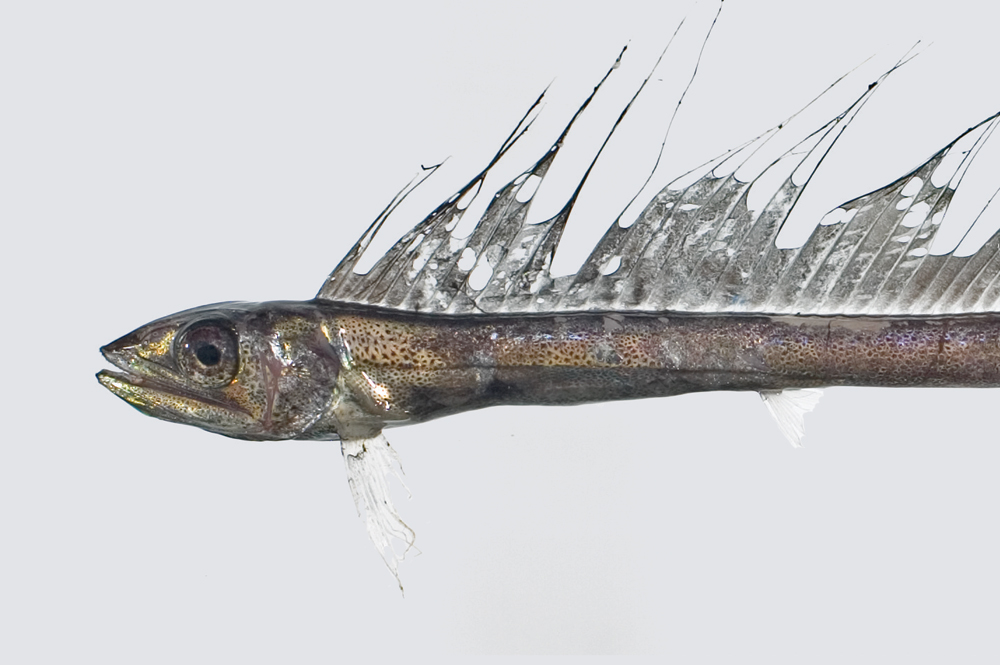- Classification
- ACTINOPTERYGII
- AULOPIFORMES
- ALEPISAURIDAE
- Alepisaurus
- brevirostris
Shortnose Lancetfish, Alepisaurus brevirostris Gibbs 1960
Other Names: Shortsnout Lancetfish, Shortsnouted Handsawfish

A juvenile Shortsnout Lancetfish, Alepisaurus brevirostris, collected during the 2003 NORFANZ Expedition to survey seamount chains in the Tasman Sea. Source: Mark McGrouther / NORFANZ Founding Parties . License: All rights reserved
Summary:
An iridescent dark bluish lancetfish becoming silvery-white below, with bluish fins. The species has a high sail-like dorsal fin, long pectoral fins, a short snout (less than one-third the head length), and enormous teeth. The dorsal fin is rounded without elongate free rays, and originates before the hind margin of the gill cover.
Cite this page as:
Bray, D.J. 2023, Alepisaurus brevirostris in Fishes of Australia, accessed 03 Jul 2025, https://fishesofaustralia.net.au/Home/species/4021
Shortnose Lancetfish, Alepisaurus brevirostris Gibbs 1960
More Info
|
Distribution |
Southern Tasmania to off Perth, Western Australia; also Macquarie Island and presumably near Heard & McDonald Islands in the Southern Ocean. Elsewhere the species is circumglobal in tropical, temperate and subantarctic waters (except the North Pacific). Inhabits mesopelagic and bathypelagic depths. |
|
Features |
Dorsal fin 40-48; Anal fin 13-16; Pectoral fin 12-14; Pelvic fin 8-10; Gill rakers 23-29. Specimens larger than 50 mm SL - head more than 6.2 in SL, snout less than one-third HL. Dorsal-fin elongate, tall, sail-like, origin in front of posterior margin of operculum; dorsal fin without free rays, low anteriorly, forming a curve that is highest near the middle; dorsal adipose fin present. |
|
Feeding |
A voracious predator that feeds on pelagic crustaceans and fishes. |
|
Biology |
A simultaneous hermaphrodite with functional ovarian and testicular tissue in an ovotestis. |
|
Similar Species |
The Longsnout Lancetfish, Alepisaurus ferox, has a relatively longer head and snout (specimens longer than about 50 cm SL), the dorsal fin originates above or behind rear margin of the gill cover, and is tall anteriorly with several free rays near the front of the fin. |
|
Etymology |
The specific name brevirostris is from the Latin brevis (= short) and rostris (= snout), in reference to the relatively shorter snout compared with that of Alepisaurus ferox. |
|
Species Citation |
Alepisaurus brevirostris Gibbs 1960, Museum of Comparative Zoology 123: 2, fig. 1. Type locality: Western North Atlantic, 38°49'N, 64°02'W. |
|
Author |
Bray, D.J. 2023 |
|
Resources |
Shortnose Lancetfish, Alepisaurus brevirostris Gibbs 1960
References
Ambrose, D.A. 1996. Alepisauridae: lancetfishes. pp. 379-381 in Moser, H.G. (ed.) The early stages of fishes in the California Current region. Fisheries Investigations Atlas No. 33 Lawrence, Kansas : California Cooperative Oceanic Allen Press, Inc. 1505 pp.
Bray, D.J. 2008. Family Alepisauridae. pp. 265-266 in Gomon. M.F., Bray, D.J. & Kuiter, R.H (eds). Fishes of Australia's Southern Coast. Sydney : Reed New Holland 928 pp.
Carpenter, K.E., Smith-Vaniz, W.F., de Bruyne, G. & de Morais, L. 2015. Alepisaurus brevirostris. The IUCN Red List of Threatened Species 2015: e.T60469186A60780091. https://dx.doi.org/10.2305/IUCN.UK.2015-4.RLTS.T60469186A60780091.en. Accessed on 06 January 2023.
Duhamel, G., Hulley, P.-A., Causse, R., Koubbi, P., et al. 2014. Chapter 7. Biogeographic Patterns of Fish. pp. 328-362 in De Broyer, C., Koubbi, P., Griffiths, H.J., Raymond, B., et al. (eds.). Biogeographic Atlas of the Southern Ocean. Cambridge : Scientific Committee on Antarctic Research 498 pp.
Francis, M.P. 1981. Meristic and morphometric variation in the lancet fish Alepisaurus, with notes on the distribution of A. ferox and A. brevirostris. New Zealand Journal of Zoology 8(3): 403-408.
Gibbs, R.H. , Jr. 1960. Alepisaurus brevirostris, a new species of lancetfish from the western North Atlantic. Breviora 123: 1-14 figs 1-3 See ref at BHL
Glover, C.J.M. 1994. Families Paralepididae, Alepisauridae. pp. 271-275 figs 242-245 in Gomon, M.F., Glover, C.J.M. & Kuiter, R.H (eds). The Fishes of Australia's South Coast. Adelaide : State Printer 992 pp. 810 figs.
Gon, O. 1990. Alepisauridae. pp. 144-145 in Gon, O. & Heemstra, P.C. (eds). Fishes of the Southern Ocean. Grahamstown : J.L.B. Smith Institute of Ichthyology 462 pp. https://doi.org/10.5962/bhl.title.141868
Heemstra, P.C. 2022. Family Alepisauridae, Lancetfishes. pp. 221-222 in Heemstra, P.C., Heemstra, E., Ebert, D.A., Holleman, W. & Randall, J.E. (eds). Coastal fishes of the western Indian Ocean. National Research Foundation & South African Institute for Aquatic Biodiversity, South Africa. Volume 2.
Heemstra, P.C. & Smith, M.M. 1986. Alepisauridae. pp. 280-281 in Smith, M.M. & Heemstra, P.C. (eds). Smith's Sea Fishes. Johannesburg : Macmillan South Africa xx + 1047 pp. 144 pls.
Russell, B.C. 2016. Families Synodontidae, Chlorophthalmidae, Notosudidae, Ipnopidae,Scopelarchidae, Evermannellidae, Alepisauridae, Omosudidae, Paralepididae, Anotopteridae, Bathysauridae, Giganturidae. pp. 1824-1854 in Carpenter, K.E. & De Angelis, N. (eds.). The Living Marine Resources of the Eastern Central Atlantic. FAO Species Identification Guide for Fishery Purposes. Bony Fishes Part 1 (Elopiformes to Scorpaeniformes). Rome : FAO Vol. 3 pp. 1511-2350.
Stewart, A.L. 2015. Families Paralepididae, Anotopteridae, Evermannellidae, Omosudidae. pp. 581-606 in Roberts, C.D., Stewart, A.L. & Struthers, C.D. The Fishes of New Zealand. Wellington : Te Papa Press Vol. 3 pp. 577-1152.


